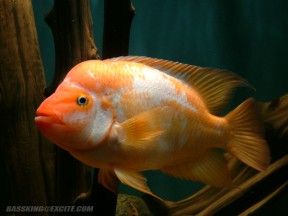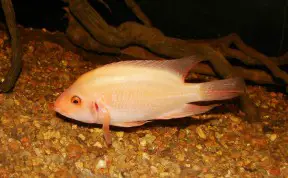Amphilophus labiatus
Red Devil Cichlid, Dicklippigerbuntbarsch (DE)
SynonymsTop ↑
Heros labiatus Günther, 1864; Heros lobochilus Günther, 1867; Cichlasoma dorsatum Meek, 1907
Etymology
Amphilophus: from the Greek amphí (Gr. ἀμφί), meaning ‘on both sides’ and lóphos (Gr. λόφος), meaning ‘crest’. The allusion was not explained, but probably refers to the enlarged lips of type species A. labiatus. However, the name might refer to the pronounced nuchal hump which develops in reproductive male individuals.
labiatus: Latin term for ‘lipped, with a well-developed lip’, in reference to the “much enlarged” anterior portions of both upper and lower lips in this species, “each forming a moveable subtriangular flap”.
Classification
Order: Perciformes Family: Cichlidae
Distribution
Endemic to the Lakes of Nicaragua and Managua in Nicaragua, Central America. These lakes are connected to each other by the Tipitapa River.
Habitat
The capital city of Nicaragua, Managua, lies on the shore of Lake Managua. The lake has suffered from massive levels of pollution as a result of this, with as much as 32 tonnes of raw sewage being dumped into the lake every day. surprisingly many fish still survive. Lake Nicaragua is larger and cleaner, and interestingly is the only freshwater lake in the world to support a population of sharks! The species in question is the bull shark Carcharhinus leucas, a species well known for its forays into freshwater rivers, and one which is genuinely dangerous, with attacks on humans being well-documented. A. labiatus is usually found close to submerged rocky areas, where it swims among the crevices.
Maximum Standard Length
300 – 350 mm.
Aquarium SizeTop ↑
A tank with base measurements of 150 cm x 45 cm or equivalent should be the minimum size considered considered for a single specimen, but you’d need something much larger for a pair or community containing other fish.
Maintenance
There are few fish that show less regard for a beautifully decorated tank than this species. Don’t even consider a planted setup, as large quantities of the substrate will be shifted around on a daily basis. Rocks, driftwood and large flowerpots are all suitable provided they’re too heavy for the fish to move about, although it will undoubtedly try to do so anyway. You could try anchoring plastic plants down with rocks, but don’t expect them to stay that way for long. If there are other fish in the tank, arrange the decor to provide as many visual barriers as possible. Although unlikely to eradicate it completely, this will at least help to dissipate aggressive behaviour.
Similarly, any unprotected pieces of equipment such as heaters, filter inlets/outlets etc. will be attacked unless they are afforded some protection. Fit the strongest heater guard you can find, or conceal the heater and any other equipment behind immovable rocky structures, and use very strong suction cups on any pipework. The filter itself should be huge and efficient to deal with the masses of biological waste produced by this greedy, messy fish. Substantial weekly water changes are also a must, and the water should be high in dissolved oxygenation. Consider the use of a couple of big airstones to achieve the latter. A heavy cover is needed to prevent the fish leaping from the tank in one of its more excitable moments, of which there will be plenty!
Water Conditions
Temperature: 21 – 26 °C
pH: 6.0 – 8.0
Hardness: 90 – 447 ppm
Diet
One of the least fussy feeders you are likely to encounter in the hobby, most specimens will attempt to eat anything that looks as though it might be edible. Feed a good quality cichlid stick as staple, and supplement this with regular feeds of live and frozen foods such as earthworms, prawns (leave the shells on as they contain valuable carotene which helps maintain the orange/yellow colouration of the fish), mussels etc. Vegetable matter, including peas, spinach should also form a good proportion of the diet. High protein foods such as beefheart and other red meats are not a suitable option, as they can have a detrimental effect on the fishes digestive system. Similarly, while it does eat smaller fish in nature, there is little benefit in feeding live fish in the aquarium.
Behaviour and CompatibilityTop ↑
One of the most downreight aggressive cichlids around, you need to know what you’re doing when attempting to keep a red devil with anything else, and that includes its own kind. In very large tanks this aggression becomes less of a problem, but by very large we are talking in excess of 1000 litres, which is simply beyond the reach of most hobbyists. In tanks of this size you can try it with other robust Central American cichlids, large Loricariids and other big catfish. Decent-sized fast swimming fish such as silver sharks, tinfoil barbs and the like are also a possibility. Keep a close eye on proceedings though, as some specimens will not tolerate any tankmates, and will systematically attack anything else in the tank. Keeping more than a single male is not usually an option in any tank, regardless of size.
Sexual Dimorphism
Mature males tend to be larger and more well built than females, and develop longer dorsal and anal fins, and a more spectacular nuchal hump. These humps only develop during the breeding season in nature, but in aquaria many specimens possess enormous, permanent humps.
Reproduction
Provided you can obtain a compatible pair, breeding is fairly straightforward. A tank of around 6′ in length is required, and this should be decorated with large rocks and flowerpots to act as potential spawning sites. It goes without saying that tankmates are not an option, as even if they are tolerated by the pair for a while, they will almost certainly be killed by the male when spawning commences.
Unfortunately matching adult fish is a very tricky process indeed, with males often killing females if they are simply added to the tank together. Some hobbyists have had success by inserting a clear divider in the middle of the tank and allowing the male to get used to his potential partner this way, removing the divider after a few weeks. There are no guarantees even with this method, though, and others prefer to keep the sexes separated by a divider at all times, even going so far as to drill holes in the divider to facilitate the transfer of sperm without the need for the fish to ever share the same space.
By far the best way to get a pair is to buy a minimum of six young fish and grow them on together, allowing pairs to form naturally. Once the first pair is spotted (this is usually quite obvious, as the others will most likely be cowering in one corner of the tank), the other fish should be removed immediately for their own safety.
Once you have a pair they should breed without too much encouragement from you. When in spawning condition, the nuchal hump of both sexes will increase in size. Courtship can be quite a prolonged and sometimes violent affair, with much tail slapping and gaping by both sexes. The female also tends to rub her lateral area along the hump of the male. Have a tank divider to hand at all times as the male can turn on his supposed mate at any time. There will also be a lot of digging activity by both fish. Just prior to spawning itself the ovipositor of the female will be clearly visible. The eggs are usually laid either in a cave or on a vertical rock surface, although in the absence of these virtually any solid surface will do. Parental care is excellent and a joy to watch, with both sexes tending to the eggs and defending their territory against all comers. This can include the fingers of unwary aquarists, so take due care if performing tank maintenance during this period.
The eggs hatch in 2-3 days and the fry are then moved to a pre-excavated pit in the substrate. They become free swimming in another 5-7 days and at this point it may be wise to install the divider to protect the female from the now hyper-aggressive male. Similarly don’t be tempted to remove the fry just yet, as this can cause the male to become a real psychopath. If the female has survived without additional protection and the young are removed, the male may attempt a second spawn, and if the female is not ready she may be killed by the confused male.
The fry can be fed on brine shrimp nauplii initially, before being offered supplementary dried foods. They grow very quickly under the correct conditions, and have a barred patterning initially, starting to change colour at around 2-2.5″ in size.
NotesTop ↑
Previously included as a member of the genus Cichlasoma, the red devil is often confused with the midas cichlid, A. citrinellus. The two can be distinguished through differences in morphology. As suggested by its scientific name, A. labiatus possesses characteristically large lips, although in reality this is variable and should not be used as a defining indicator of species. Certainly, tank bred fish tend not to have these large lips. More reliable differences include the bigger nuchal hump and more thick-set appearance in A. citrinellus. These two have been hybridised within the hobby to such an extent that it can often be difficult to find a purebred fish of either species.
While most wild members of the species are a somewhat nondescript grey colour, some individuals exhibit a degree of orange or red patterning, and it is these fish that have been selectively bred for colour in the aquarium trade. This has resulted in a number of different colour forms becoming available, including white, grey, yellow, orange, red, barred and piebald forms. Unfortunately intentional hybridisation between this and other species is thought to have occured extensively, giving rise to aquarium sport fish such as the parrot cichlid and flowerhorn, a process we find abhorrent.
Despite its belligerent nature, it remains one of the most popular aquarium species among cichlidophiles due to its endearing personality. Captive specimens quickly learn to recognise their owner and exhibit a level of intelligence far beyond that of most commonly kept fish.



